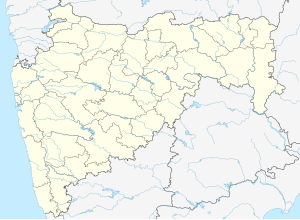This is an old revision of this page, as edited by PerspicazHistorian (talk | contribs) at 08:24, 21 December 2024 (reflist and categ add). The present address (URL) is a permanent link to this revision, which may differ significantly from the current revision.
Revision as of 08:24, 21 December 2024 by PerspicazHistorian (talk | contribs) (reflist and categ add)(diff) ← Previous revision | Latest revision (diff) | Newer revision → (diff) Village in Maharashtra, India| Manjarsumba Fort | |
|---|---|
| किल्ले मांजरसुभा / मांजरसुंबा | |
| Beed tehsil, Beed, Maharashtra, India | |
 Ruins of Manjarsumbha Fort, created by Ahmednagar's Nizam in 15th century for territorial watch over the wambori region around ahmednagar. Ruins of Manjarsumbha Fort, created by Ahmednagar's Nizam in 15th century for territorial watch over the wambori region around ahmednagar. | |
 | |
| Coordinates | 19°15′4″N 74°44′56″E / 19.25111°N 74.74889°E / 19.25111; 74.74889 |
| Type | Hill fort |
| Height | 3,580 Ft. |
| Site information | |
| Open to the public | Yes |
| Condition | Ruins |
| Site history | |
| Materials | Stone, bricks, alkali |
Manjarsumbha, is a small village in Beed district, of Maharashtra State, India. It belongs to Khandesh and Northern Maharashtra region.
Significance
Manjarsumbha is mainly known for sanjeevani samadhi of 17th century Lingayat saint Manmath Swami. The site is located approximately 1.60 km (about a mile) from Manjarsumbha, set in a scenic area with a small waterfall cascading from a hill that stands about 9.64 meters (30 feet) tall. The samadhi of the Swami is housed in a 1.114 sq. meter (12 ft. square) chamber, topped with a modest but well-crafted spire. On the walls of the chamber are painted images of Shankar Mahadev in meditative poses. The sabhamandap, featuring a homakund in the center, is open on all sides. Nearby pavilions have been built to accommodate pilgrims who come from distant places to participate in the annual yatra during Magha, coinciding with the Tulsi vivaha ceremony. This event lasts for five days and attracts around 3,000 people.
Waterfall
The waterfall points are located at the hills of Gorakhnath, which rise to 2,952 feet, as well as at Manjarsumbha and Dongargan. At the base of Manjarsumbha is a small valley that opens to the north, commonly known as the Happy Valley. Manjarsumbha hill rises above this Happy Valley or Dongargaon glen, while the crescent-shaped plateau surrounding the village of Agadgaon has an elevation of 3,192 feet. The area is pleasantly cool with abundant trees, wildflowers, and plants that thrive in the moisture-rich environment created by the waterfall.
Nizam Era
The region also has a fort, Manjarsumbha Fort, built during the Nizamshahi in the 14th century. The fort is triangular in shape spread over area of 8 acres. The major role of fort was to oversee trade routes and maintain territorial control of nizams over the region.
References
- "The Gazetteers Department - Bhir". gazetteers.maharashtra.gov.in. Archived from the original on 2024-06-30. Retrieved 2024-12-21.
- ^ "The Gazetteers Department - Bhir". gazetteers.maharashtra.gov.in. Archived from the original on 2024-06-30. Retrieved 2024-12-21.
- Maharashtra State Gazetteers: General Series. Directorate of Government Printing, Stationery and Publications. 1953.
- Nagarkar, D. D. (1977). Glimpses of Ahmednagar. Municipal Councils Ahmednagar District Historical Museum.
- The Gazetteer of Bombay Presidency: Ahmadnagar District. Printed at the Government Photozinco Press. 1985.
- "Manjarsumba Fort". Ahmednagar Online. Retrieved 2024-12-21.
- History: Mediaeval period. Directorate of Government Printing, Stationery and Publications, Maharashtra State. 1967.
- "MANJARSUMBHA". Durgbharari. Retrieved 2024-12-21.